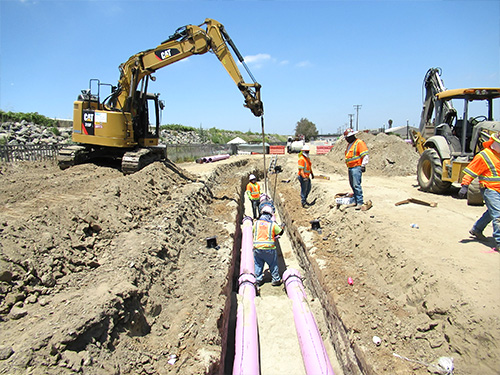
Construction Management/Inspection

AKM is currently providing construction management, inspection, and design quality control services for the City of Long Beach Municipal Urban Stormwater Treatment (LB-MUST) Facility. The project is designed to intercept non-stormwater runoff and capture a percentage of the first-flush storm flows generated within the City of Long Beach urban watersheds before discharging into existing storm drain outfalls flowing into the Los Angeles River and the Los Angeles River Estuary. The key system elements include:
The project is divided into three (3) phases (clearing and grubbing/ initial site preparation (underground utilities and ground stabilization), treatment facility construction, and conveyance system construction).
AKM provided construction management and inspection for this phase, which included clearing and grubbing of the proposed site, initial rough grading of the site, removal of buried railroad tracks and ties, installation of K-rail and fencing around the site, establishment of long term stormwater best management practices (BMPs) for the disturbed area and weekly BMP inspections. The work also required the City to relocate a homeless encampment within the work zone. In 2020, AKM provided construction management services for Phase II of the program which included the construction of a new low voltage electrical service, reconstruction and realignment of the roadway fronting the proposed treatment plant site, underground utilities such as water, storm drain and recycled water, as well as the installation of 3,100 linear feet of the conveyance pressure pipe system.
AKM oversaw ground improvement work, which included furnishing all plant, labor, equipment, and materials; performing all operations as required to construct the deep soil mixing (DSM) ground improvements; and providing all associated testing, monitoring, sampling, and recording. Specific work included: mobilization/demobilization; SWPPP; excavation and placement of 2 stockpiles; disposal of hazardous soil; surveying; Deep Soil Mixing construction in full compliance with bid documents; quality control; and construction of a load transfer platform
AKM provided quality control and constructability review for the 90% design package of the LB-MUST treatment plant and conveyance system and is currently managing construction and inspection during implementation. The treatment plant is designed to process both brackish and non-brackish influent flows through separate treatment trains. The treatment process consists of influent strainers, ceramic membrane ultra-filtration (UF), and an advanced oxidation process (UV/AOP). Additional processes include pumping, storage tanks, chemical feeding, and air supply systems. The facility has also been designed to allow for the future addition of a reverse osmosis (RO) system to reduce TDS levels and provide additional barriers for potential potable reuse applications. The ceramic membrane system, which consists of two 1-million-gallon-per-day (MGD) units, as well as the UV/AOP system, was pre-purchased by the City. The treatment facility will be housed in a 9,000-square-foot cement masonry unit building, which will include electrical, chemical, and control rooms, as well as an HVAC and mechanical system. As part of the LB-MUST project, a new wetlands area and pedestrian walking path are being constructed. This portion of the work includes the demolition of an existing light industrial warehouse and associated structures, grading and excavation for the wetlands, installation of an impermeable liner at the wetlands bottom, and construction of reinforced concrete inlet and outlet structures with sluice gates. Additional work involves relocating utilities, installing pedestrian pathways around the wetlands, and upgrading the stormwater pumping system within the existing SD-02 Pump Station. The demolition activities included abatement and removal of the existing warehouse, appurtenant structures, parking lot, and interfering portions of utilities and infrastructure. Pump station improvements involved installing a submersible sump pump, new piping, valves, electrical work, and instrumentation to enhance operational efficiency.